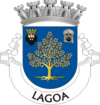Lagoa, Algarve
| Lagoa | |||
|---|---|---|---|
| Municipality | |||

Sea coast of municipality of Lagoa
|
|||
|
|||
 |
|||
| Coordinates: 37°8′N 8°27′W / 37.133°N 8.450°WCoordinates: 37°8′N 8°27′W / 37.133°N 8.450°W | |||
| Country |
|
||
| Region | Algarve | ||
| Subregion | Algarve | ||
| Intermunic. comm. | Algarve | ||
| District | Faro | ||
| Parishes | 4 | ||
| Government | |||
| • President | Fracisco José Malveiro Martins (PS) | ||
| Area | |||
| • Total | 88.25 km2 (34.07 sq mi) | ||
| Lowest elevation | 0 m (0 ft) | ||
| Population (2011) | |||
| • Total | 22,975 | ||
| • Density | 260/km2 (670/sq mi) | ||
| Time zone | WET/WEST (UTC+0/+1) | ||
| Postal code | 8401 | ||
| Patron | Our Lady of Light | ||
| Website | http://www.cm-lagoa.pt | ||
Lagoa (Portuguese pronunciation: [lɐˈɣoɐ]) is a municipality in the former-district of Faro, in the Portuguese region of the Algarve. The population in 2011 was 22,975, in an area of 88.25 km². Its urban population is 6100 inhabitants.
According to some historical sources, the earliest settlement in the area occurred along the edges of small lakes or marshes (Portuguese: lagoa), which were drained in order to create a fertile land. There are many pre-historic vestiges of the early settlements, including menhirs (standing stones), funerary necropoles and artifacts that date a human presence to remote history. The entire region of the Algarve was conquered by the Arabs when they moved into the Iberian peninsula in the 8th century.
When the area was later reconquered in the mid-12th century by Christian forces from the north, it was integrated into the fledgling Kingdom of Portugal. Muslim influence in Lagoa was profound, from the rich patrimony left behind, not only in neighboring Silves (then taifa capital), but also in Lagoa where commerce thrived.
During the 14th century, a favorable confluence of conditions allowed Lagoa to develop rapidly. Yet, the events of the 1755 Lisbon earthquake left little marks from this period: the reconstruction wiped away many of its classic architecture (there are a rare few of this period, including the churches of Estômbar and Porches.
The coastal zone was, for centuries, attacked by pirates and corsairs, and those responsible for public security erected various defensive structures along the coast, such as the fortresses of Nossa Senhora da Rocha, Carvoeiro and São João de Ferragudo, in addition to the lookouts and redoubts, such as the tower of Lapa or Marinha.
For a long period, Lagoa was governed within the municipality of Silves. On the 16 January 1773, a foral (charter) was issued King Joseph I, incorporating the municipality of Lagoa, after its principal settlement (Lagoa) was elevated to the status of town (Portuguese: vila).
...
Wikipedia


